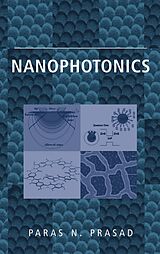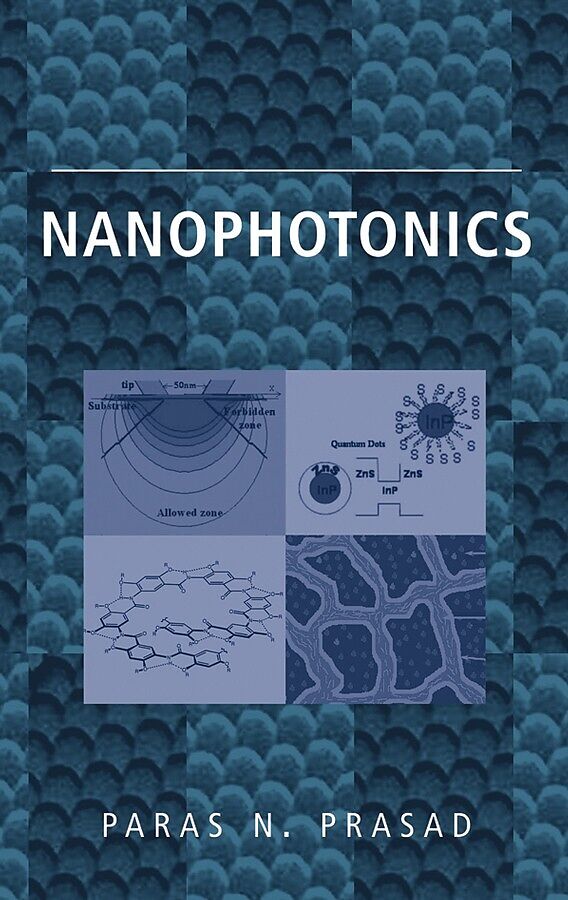Nanophotonics
Format:
E-Book (pdf)
EAN:
9780471670247
Untertitel:
Englisch
Genre:
Chemie
Autor:
Paras N. Prasad
Herausgeber:
Wiley-Interscience
Anzahl Seiten:
432
Erscheinungsdatum:
21.09.2004
ISBN:
978-0-471-67024-7
The only comprehensive treatment of nanophotonics currently
available
Photonics is an all-encompassing optical science and technology
which has impacted a diverse range of fields, from information
technology to health care. Nanophotonics is photonic science and
technology that utilizes light-matter interactions on the
nanoscale, where researchers are discovering new phenomena and
developing technologies that go well beyond what is possible with
conventional photonics and electronics. These new technologies
could include efficient solar power generation, high-bandwidth and
high-speed communications, high-capacity data storage, and
flexible- and high-contrast displays. In addition, nanophotonics
will continue to impact biomedical technologies by providing new
and powerful diagnostic techniques, as well as light-guided and
activated therapies.
Nanophotonics provides the only available comprehensive treatment
of this exciting, multidisciplinary field, offering a wide range of
topics covering:
* Foundations
* Materials
* Applications
* Theory
* Fabrication
Nanophotonics introduces students to important and timely concepts
and provides scientists and engineers with a cutting-edge
reference. The book is intended for anyone who wishes to learn
about light-matter interactions on the nanoscale, as well as
applications of photonics for nanotechnology and nanobiotechnology.
Written by an acknowledged leader in the field, this text provides
an essential resource for those interested in the future of
materials science and engineering, nanotechnology, and photonics.
Autorentext
PARAS N. PRASAD is the SUNY Distinguished Professor of Chemistry, Physics, Electrical Engineering, and Medicine; the Samuel P. Capen Chair; and the Executive Director of the Institute of Lasers, Photonics, and Biophotonics at the University of Buffalo. Professor Prasad has published over 450 scientific papers and lectured worldwide on nanophotonics. He has offered a multidisciplinary course on nanophotonics at Buffalo as well as a short course on this subject at the SPIE professional society meetings. In May 2001, the U.S. Department of Defense, under its nanotechnology initiative, chose the Institute of Lasers, Photonics, and Biophotonics in Buffalo to lead a comprehensive multidisciplinary program in Nanophotonics involving a world-class consortium of researchers at the University of California at Berkeley, Massachusetts Institute of Technology, the University of Washington, and Yale University.
Zusammenfassung
The only comprehensive treatment of nanophotonics currently available
Photonics is an all-encompassing optical science and technology which has impacted a diverse range of fields, from information technology to health care. Nanophotonics is photonic science and technology that utilizes light-matter interactions on the nanoscale, where researchers are discovering new phenomena and developing technologies that go well beyond what is possible with conventional photonics and electronics. These new technologies could include efficient solar power generation, high-bandwidth and high-speed communications, high-capacity data storage, and flexible- and high-contrast displays. In addition, nanophotonics will continue to impact biomedical technologies by providing new and powerful diagnostic techniques, as well as light-guided and activated therapies.
Nanophotonics provides the only available comprehensive treatment of this exciting, multidisciplinary field, offering a wide range of topics covering:
* Foundations
* Materials
* Applications
* Theory
* Fabrication
Nanophotonics introduces students to important and timely concepts and provides scientists and engineers with a cutting-edge reference. The book is intended for anyone who wishes to learn about light-matter interactions on the nanoscale, as well as applications of photonics for nanotechnology and nanobiotechnology. Written by an acknowledged leader in the field, this text provides an essential resource for those interested in the future of materials science and engineering, nanotechnology, and photonics.
Inhalt
Preface. Acknowledgments. 1. Introduction. 1.1 NanophotonicsAn Exciting Frontier in Nanotechnology. 1.2 Nanophotonics at a Glance. 1.3 Multidisciplinary Education, Training, and Research. 1.4. Rationale for this Book. 1.5 Opportunities for Basic Research and Development of New Technologies. 1.6 Scope of this Book. References. 2. Foundations for Nanophotonics. 2.1 Photons and Electrons: Similarities and Differences. 2.1.1 Free-Space Propagation. 2.1.2 Confinement of Photons and Electrons. 2.1.3 Propagation Through a Classically Forbidden Zone: Tunneling. 2.1.4 Localization Under a Periodic Potential: Bandgap. 2.1.5 Cooperative Effects for Photons and Electrons. 2.2 Nanoscale Optical Interactions. 2.2.1 Axial Nanoscopic Localization. 2.2.2 Lateral Nanoscopic Localization. 2.3 Nanoscale Confinement of Electronic Interactions. 2.3.1 Quantum Confinement Effects. 2.3.2 Nanoscopic Interaction Dynamics. 2.3.3 New Cooperative Transitions. 2.3.4 Nanoscale Electronic Energy Transfer. 2.3.5 Cooperative Emission. 2.4 Highlights of the Chapter. References. 3. Near-Field Interaction and Microscopy. 3.1 Near-Field Optics. 3.2 Theoretical Modeling of Near-Field Nanoscopic Interactions. 3.3 Near-Field Microscopy. 3.4 Examples of Near-Field Studies. 3.4.1 Study of Quantum Dots. 3.4.2 Single-Molecule Spectroscopy. 3.4.3 Study of Nonlinear Optical Processes. 3.5 Apertureless Near-Field Spectroscopy and Microscopy. 3.6 Nanoscale Enhancement of Optical Interactions. 3.7 Time- and Space-Resolved Studies of Nanoscale Dynamics. 3.8 Commercially Available Sources for Near-Field Microscope. 3.9 Highlights of the Chapter. References. 4. Quantum-Confined Materials. 4.1 Inorganic Semiconductors. 4.1.1 Quantum Wells. 4.1.2 Quantum Wires. 4.1.3 Quantum Dots. 4.1.4 Quantum Rings. 4.2 Manifestations of Quantum Confinement. 4.2.1 Optical Properties. 4.2.2 Examples. 4.2.3 Nonlinear Optical Properties. 4.2.4 Quantum-Confined Stark Effect. 4.3 Dielectric Confinement Effect. 4.4 Superlattices. 4.5 Core-Shell Quantum Dots and Quantum Dot-Quantum Wells. 4.6 Quantum-Confined Structures as Lasing Media. 4.7 Organic Quantum-Confined Structures. 4.8 Highlights of the Chapter. References. 5. Plasmonics. 5.1 Metallic Nanoparticles and Nanorods. 5.2 Metallic Nanoshells. 5.3 Local Field Enhancement. 5.4 Subwavelength Aperture Plasmonics. 5.5 Plasmonic Wave Guiding. 5.6 Applications of Metallic Nanostructures. 5.7 Radiative Decay Engineering. 5.8 Highlights of the Chapter. References. 6. Nanocontrol of Excitation Dynamics. 6.1 Nanostructure and Excited States. 6.2 Rare-Earth Doped Nanostructures. 6.3 Up-Converting Nanophores. 6.4 Photon Avalanche. 6.5 Quantum Cutting. 6.6 Site Isolating Nanoparticles. 6.7 Highlights of the Chapter. References. 7. Growth and Characterization of Nanomaterials. 7.1 Growth Methods for Nanomaterials. 7.1.1 Epitaxial Growth. 7.1.2 Laser-Assisted Vapor Deposition (LAVD). 7.1.3 Nanochemistry. 7.2 Characterization of Nanomaterials. 7.2.1 X-Ray Characterization. 7.…

Leider konnten wir für diesen Artikel keine Preise ermitteln ...
billigbuch.ch sucht jetzt für Sie die besten Angebote ...
Die aktuellen Verkaufspreise von 2 Onlineshops werden in Realtime abgefragt.
Sie können das gewünschte Produkt anschliessend direkt beim Anbieter Ihrer Wahl bestellen.
Loading...
Die aktuellen Verkaufspreise von 2 Onlineshops werden in Realtime abgefragt.
Sie können das gewünschte Produkt anschliessend direkt beim Anbieter Ihrer Wahl bestellen.
| # | Onlineshop | Preis CHF | Versand CHF | Total CHF | ||
|---|---|---|---|---|---|---|
| 1 | Seller | 0.00 | 0.00 | 0.00 |
